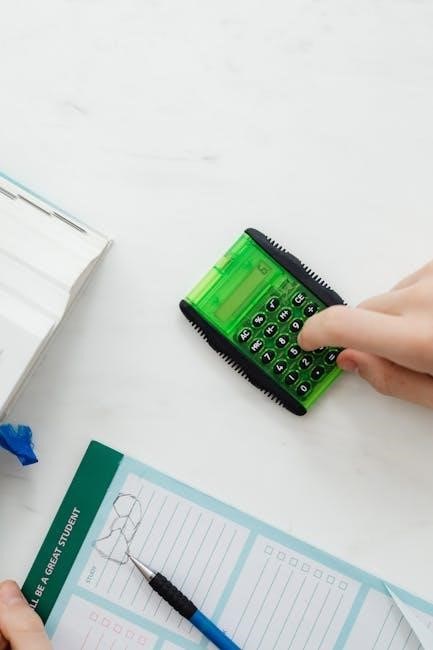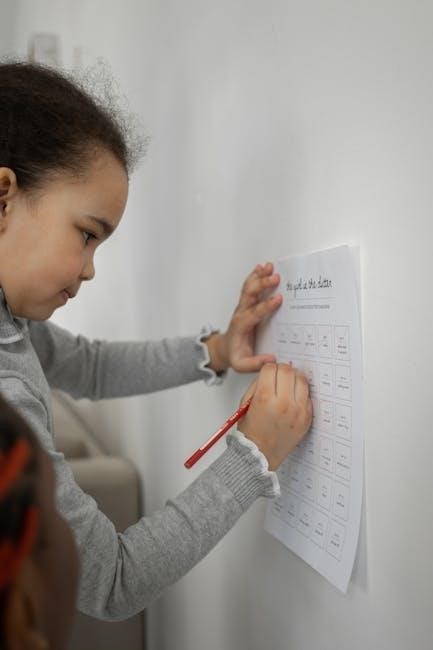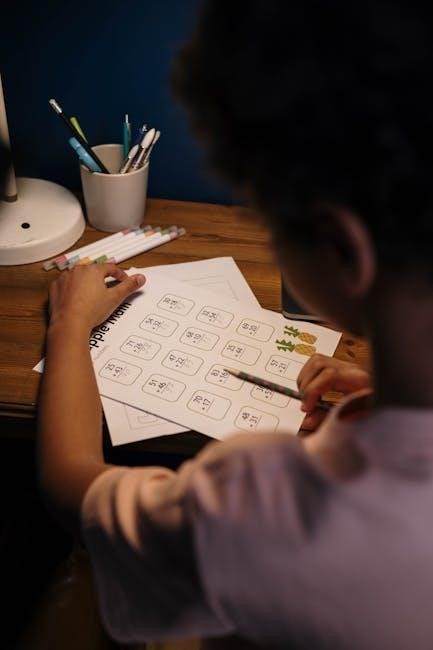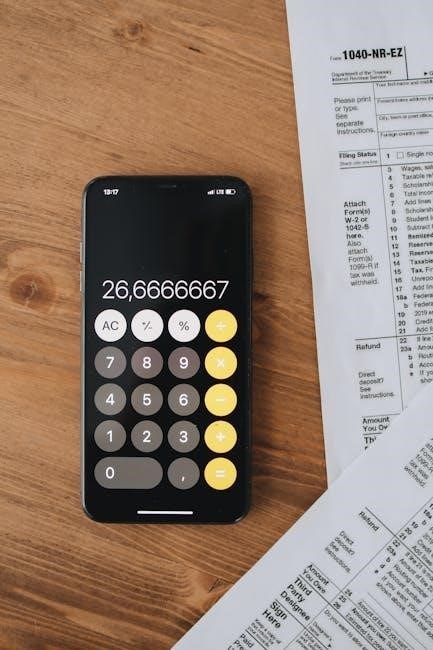Welcome to our comprehensive guide to multiplying decimals worksheets! These resources focus on building confidence in decimal multiplication, covering topics like multiplying decimals by whole numbers, other decimals, and by 10, 100, or 1000. Ideal for grades 4-6, these worksheets offer a variety of engaging activities and challenges to master decimal multiplication skills.
Overview of Multiplying Decimals
Multiplying decimals is an essential math skill that builds on whole number multiplication. When multiplying decimals, the process involves setting up the problem like regular multiplication, ignoring the decimal points initially. After obtaining the product, the decimal point is placed by counting the total number of decimal places in both factors and positioning it accordingly in the result; Worksheets on this topic cover various scenarios, such as multiplying decimals by whole numbers, other decimals, or multiples of ten. These exercises help students grasp the concept of scaling numbers and understanding the impact of decimal placement on the final product. By practicing with structured problems, learners develop accuracy and confidence in handling decimal multiplication, preparing them for more complex mathematical operations.
Why Use Worksheets for Learning Decimal Multiplication?
Worksheets are an effective tool for teaching and mastering decimal multiplication. They provide a structured format that helps students organize their thoughts and approach problems systematically. By using worksheets, learners can practice a variety of problems, from simple to complex, in a focused environment. This repetition builds fluency and confidence in handling decimals. Worksheets also allow for immediate feedback, as students can compare their answers to the correct solutions. Additionally, they offer a visual learning experience, making it easier to understand the placement of decimal points and the scaling of numbers. Regular practice with worksheets helps reinforce concepts and ensures long-term retention of skills. They are also versatile, catering to different learning paces and styles, making them ideal for both classroom and home use.

Methods for Multiplying Decimals
Multiplying decimals involves standard multiplication of whole numbers, followed by decimal placement based on the total number of decimal places in the factors.
Step-by-Step Guide to Multiplying Decimals
Multiplying decimals requires careful attention to the placement of the decimal point. Start by ignoring the decimal points and multiplying the numbers as if they were whole numbers. Next, count the total number of decimal places in both factors. After obtaining the product, place the decimal point in the result by moving it to the left by the total number of decimal places counted earlier. For example, multiplying 4.2 by 3.5 involves multiplying 42 and 35 to get 1470, then placing the decimal point three places to the left, resulting in 44.1. This method ensures accuracy and simplifies the process; Using worksheets can help students practice and master this technique effectively.
Setting Up Decimal Multiplication Problems

Setting up decimal multiplication problems involves aligning the numbers correctly and positioning the decimal points. To begin, write the two decimals one above the other, ensuring their place values align properly. The decimal points should be directly below each other to maintain accuracy. For example, when multiplying 3.4 by 2.5, align the numbers as follows:
3.4
× 2.5
------
Next, extend the lines or use a ruler to keep the numbers straight, which helps in maintaining proper placement. This setup ensures that the decimal point in the product will be correctly positioned later. Always double-check the alignment before proceeding with the multiplication. Proper setup is crucial to avoid errors and ensure the decimal point is placed accurately in the final product. This step is foundational for mastering decimal multiplication.
Placing the Decimal Point in the Product
Placing the decimal point in the product is a critical step in multiplying decimals. After multiplying the numbers as if they were whole numbers, count the total number of decimal places in both the multiplicand and the multiplier. This total determines where the decimal point goes in the final product. For example, multiplying 4.5 (one decimal place) by 2.3 (one decimal place) results in 10.35 (two decimal places). Always count carefully to avoid errors. If the product is a whole number, the decimal point is placed at the end. This method ensures accuracy and maintains the correct value of the product. Proper placement of the decimal point is essential for valid results in decimal multiplication problems. Regular practice helps master this skill effectively.

Types of Multiplying Decimals Problems
Multiplying decimals problems vary, including multiplying by whole numbers, decimals, or powers of 10. Problems may involve multi-digit decimals or require column multiplication for accuracy. Each type builds foundational skills for real-world applications.
Multiplying Decimals by Whole Numbers
Multiplying decimals by whole numbers is a fundamental skill that introduces learners to decimal operations. This type of problem involves multiplying a decimal by an integer, requiring careful placement of the decimal point. Learners must first ignore the decimal, multiply the numbers as whole numbers, and then count the total number of decimal places in the original decimal to place the point correctly. For example, multiplying 4.5 by 3 involves multiplying 45 by 3 to get 135, then placing the decimal one place from the right to get 13.5. This method ensures accuracy and builds a strong foundation for more complex decimal multiplication. Practice worksheets help students master this essential math skill through repetitive exercises and real-world applications.
Multiplying Decimals by Decimals
Multiplying decimals by decimals requires a step-by-step approach to ensure accuracy. First, ignore the decimal points and multiply the numbers as whole numbers; Then, count the total number of decimal places in both factors and place the decimal point in the product accordingly. For example, multiplying 2.5 by 0.4 involves multiplying 25 by 4 to get 100, then placing the decimal point three places from the right to get 1.00. This method helps students understand how decimals interact during multiplication. Worksheets provide structured exercises to practice this skill, reinforcing the concept of decimal placement and its impact on the final result. Regular practice with real-world problems, such as calculating areas or scaling recipes, helps solidify this essential math skill.
Multiplying Decimals by 10, 100, or 1000
Multiplying decimals by 10, 100, or 1000 is a straightforward process that simplifies calculations. When multiplying by 10, move the decimal point one place to the right (e.g., 2.5 becomes 25.0). Multiplying by 100 shifts the decimal two places to the right (e.g., 3.4 becomes 340.0), and multiplying by 1000 moves it three places (e.g., 1.2 becomes 1200.0). This method avoids complex arithmetic and is especially useful for mental math. Worksheets provide numerous exercises to practice this skill, reinforcing the concept of decimal placement. Mastering this technique is beneficial for real-world applications, such as scaling recipes or adjusting measurements, where quantities need to be easily increased by multiples of ten. Regular practice with these problems helps build confidence and fluency in decimal multiplication.
Multiplying Decimals in Columns
Multiplying decimals in columns is a method that aligns with how whole numbers are multiplied, but with an added focus on decimal placement. Start by ignoring the decimal points and multiplying the numbers as if they were whole numbers. After obtaining the product, count the total number of decimal places in both factors and place the decimal point in the product accordingly. For example, multiplying 4.2 by 2.5 involves multiplying 42 by 25 to get 1050, then placing the decimal three places left to get 21.0. Worksheets often include column multiplication problems to help students practice aligning numbers and placing decimals correctly. This skill is essential for maintaining accuracy in complex calculations and ensures that students can apply decimal multiplication in various real-world scenarios. Regular practice with column multiplication builds proficiency and reduces errors over time.

Free Multiplying Decimals Worksheets
Free multiplying decimals worksheets are widely available online, offering a variety of problems for different skill levels. They are ideal for home or classroom use and can be downloaded as PDFs for easy printing. These resources provide structured practice, helping students master decimal multiplication without additional costs. Teachers and parents can find these worksheets on educational websites, ensuring accessible learning opportunities for everyone. They are designed to save time while promoting effective skill development in a clear and organized format.
Benefits of Using Free PDF Worksheets
Free PDF worksheets for multiplying decimals offer numerous benefits, making them a valuable resource for students and educators. They are easily accessible, cost-effective, and provide a structured approach to learning decimal multiplication. PDF formats ensure consistency and clarity, making them ideal for printing and sharing. These worksheets often include a variety of problems tailored to different skill levels, catering to both beginners and advanced learners. They also save time for teachers, as they are pre-designed and ready to use. Many worksheets include answer keys, enabling self-assessment and immediate feedback. Additionally, free PDF resources reduce educational costs, making high-quality learning materials available to everyone. Their portability and ease of use make them a practical choice for both classroom and home learning environments.
Recommended Websites for Free Worksheets
Several websites offer high-quality free PDF worksheets for multiplying decimals, providing convenient access to educational resources. Khan Academy, MathWorks, and Teachers Pay Teachers are among the top platforms, offering a wide range of worksheets tailored to different grade levels and skill sets. These websites often categorize their resources, making it easy to find specific topics like decimal multiplication. Many worksheets are designed by educators, ensuring they align with curriculum standards. Additionally, sites like Math-Aids and Worksheet Genius provide customizable options, allowing users to generate worksheets based on their needs. These platforms are user-friendly, with easy download options and printable formats, making them ideal for both students and teachers seeking reliable learning materials.
Expert-Approved Learning Resources
Expert-approved learning resources are essential for mastering decimal multiplication; Websites like Khan Academy and MathWorks provide comprehensive guides and worksheets that align with educational standards. Platforms such as Teachers Pay Teachers and Math-Aids offer curated worksheets designed by experienced educators, ensuring quality and relevance. These resources often include step-by-step instructions, video tutorials, and interactive exercises to enhance understanding. Additionally, many of these platforms offer customizable worksheets, allowing teachers to tailor exercises to their students’ needs. Expert-endorsed resources are particularly beneficial because they are vetted for accuracy and effectiveness, making them reliable tools for both classroom and home learning environments. They cater to diverse learning styles, ensuring that students grasp the fundamentals of decimal multiplication confidently and effectively.

Grade-Specific Worksheets
Grade-specific worksheets cater to students’ learning needs, offering targeted practice for multiplying decimals. They align with curriculum standards, ensuring age-appropriate challenges and skill development. Available for grades 4-6.
5th Grade Multiplying Decimals Worksheets
5th-grade worksheets focus on building proficiency in multiplying decimals, essential for advanced math skills. These resources are designed to align with curriculum standards, offering comprehensive practice for students. Worksheets include problems like multiplying decimals by whole numbers and other decimals, with clear instructions and examples. They also cover placing decimal points correctly and simplifying results. Interactive PDF formats make learning engaging, while step-by-step solutions help with understanding. These materials cater to different learning styles, reinforcing concepts through repetition and variety. Regular practice with these worksheets ensures fluency and confidence, preparing students for real-world applications and higher-grade challenges.
6th Grade Multiplying Decimals Worksheets
6th-grade worksheets on multiplying decimals are tailored to enhance mathematical fluency and problem-solving skills. These resources introduce more complex scenarios, such as multiplying multi-digit decimals and solving word problems involving real-world applications. Worksheets often include mixed-number multiplication and advanced placement of decimal points. PDF formats provide clear layouts and step-by-step guides, making them ideal for independent practice. Interactive elements, like fill-in-the-blank exercises, engage students and reinforce concepts. Additionally, these worksheets emphasize the transition from basic operations to algebraic thinking, preparing students for higher-level math. Regular use of these materials fosters accuracy and speed, ensuring mastery of decimal multiplication for future academic success.
Worksheets for Grades 4 to 6
Worksheets designed for Grades 4 to 6 provide a comprehensive approach to mastering decimal multiplication. These resources gradually build skills, starting with simple problems for younger students and progressing to more complex scenarios. For 4th graders, worksheets often focus on introducing decimal concepts, while 5th graders tackle multiplying decimals by whole numbers and basic decimal-to-decimal multiplication. By 6th grade, students engage with multi-digit decimals and real-world word problems. These worksheets align with curriculum standards, ensuring a smooth transition between grade levels. They also emphasize practical applications, such as calculating quantities in recipes or measuring materials for crafts. PDF formats make these worksheets easy to access and print, offering organized and structured practice for young learners.

Advanced Multiplying Decimals Topics
Advanced topics involve multiplying multi-digit decimals, addressing missing factors, and solving complex word problems. These challenges require precision and strategic thinking, building on foundational skills for mastery.
Multiplying Multi-Digit Decimals
Multiplying multi-digit decimals is a challenging yet essential skill for mastering decimal operations. This involves multiplying numbers with multiple digits before and after the decimal point. To solve such problems, students first multiply the numbers as if they were whole numbers, ignoring the decimal points. After obtaining the product, the decimal point is placed by counting the total number of decimal places in both factors. For example, multiplying 4.25 by 3.50 requires multiplying 425 by 350 to get 14875, then placing the decimal point four places to the left, resulting in 148.75. This method ensures accuracy and builds confidence in handling complex calculations. Worksheets with multi-digit decimal problems are ideal for targeted practice, helping students refine their skills and apply them to real-world scenarios.
Multiplying Decimals with Missing Factors
Multiplying decimals with missing factors involves solving for an unknown number in a multiplication equation. For instance, if the equation is 4.2 × ___ = 21.6, students must find the missing factor by dividing 21.6 by 4.2, resulting in 5.1. This skill enhances problem-solving abilities and understanding of inverse operations; Worksheets designed for this purpose provide structured practice, often including word problems that require identifying the missing factor in real-world contexts, such as calculating quantities in recipes or scaling measurements. Regular practice with these exercises builds confidence and fluency in handling decimal multiplication challenges, preparing students for advanced algebraic concepts in the future.
Word Problems Involving Decimal Multiplication
Word problems involving decimal multiplication are essential for applying mathematical skills to real-life scenarios. Worksheets often include practical examples, such as calculating the area of a room, scaling recipes, or determining costs. For instance, finding the cost of paint needed to cover a wall at $2.50 per liter when the wall requires 4.8 liters. These problems enhance critical thinking and the ability to interpret and solve mathematical questions in context. By practicing with structured worksheets, students improve their reading comprehension and accuracy in identifying the correct multiplication operations. This skill is crucial for everyday tasks and advanced mathematical studies, making decimal multiplication word problems a vital part of learning. Regular practice builds confidence and ensures mastery of practical applications.

Practice and Mastery

Regular practice is essential for mastering decimal multiplication. Consistent effort builds accuracy, confidence, and fluency in solving mathematical problems.
Engaging Activities for Decimal Multiplication
Engaging activities make learning decimal multiplication fun and effective. Group work, such as solving problems together, fosters collaboration and peer learning. Using manipulatives like base-ten blocks helps visualize decimal places, while real-world applications, such as calculating costs or measurements, make concepts relatable. Technology integration, like educational apps or online games, adds interactivity. Incorporating challenges, such as timed drills or team competitions, boosts excitement and speed. Hands-on projects, like creating shopping lists or recipes, apply multiplication skills practically. These activities not only enhance understanding but also build confidence and motivation for students.
Hands-On Exercises for Better Understanding
Hands-on exercises are essential for grasping decimal multiplication concepts; Using physical manipulatives, such as coins or measuring tools, helps students visualize decimal placement; Activities like creating models of decimal products or solving problems with real-world objects, like money or recipes, deepen understanding. Writing decimal multiplication problems on whiteboards or chalkboards encourages active participation. Craft projects, such as measuring fabric or ingredients, apply skills practically. These exercises make abstract concepts tangible, reducing confusion and anxiety. They also allow students to explore and experiment, fostering a deeper connection to the material. Regular hands-on practice builds confidence and ensures mastery of decimal multiplication skills in a engaging and interactive way.
Challenges to Test Mastery
Challenges to test mastery in multiplying decimals are crucial for assessing a student’s understanding and application of the concept. These challenges often involve complex problems, such as multiplying multi-digit decimals by whole numbers or other decimals, requiring precise placement of the decimal point. Word problems are another effective way to test mastery, as they demand students to compute the product and interpret the context. Incorporating mixed operations, like multiplying and then adding or subtracting, adds difficulty. Timed exercises and problem sets with increasing complexity help identify areas needing review. Utilizing these challenges in practice routines ensures students develop a robust foundation in decimal multiplication, preparing them for advanced mathematical concepts.

Tools and Resources
Access a variety of tools and resources, including printable PDF worksheets, online platforms, and educational apps, to enhance learning and practice multiplying decimals effectively.
Decimal Multiplication Videos and Tutorials
Engage with video tutorials and online resources to master decimal multiplication. Platforms like Khan Academy and YouTube offer step-by-step guides and real-world examples. Channels such as 3Blue1Brown provide animated explanations, while Math Antics offers detailed breakdowns. Interactive simulations on GeoGebra allow learners to visualize decimal multiplication processes. Websites like IXL and Coolmath provide interactive lessons with audio and visual aids. These tools cater to diverse learning styles, ensuring understanding and retention. Additionally, many tutorials include quizzes and exercises for practice. Use these resources to supplement worksheets and reinforce concepts. Videos are especially helpful for visual learners, while interactive simulations engage hands-on learners. Regularly watching and practicing with these tools can significantly improve proficiency in multiplying decimals.
Interactive Worksheets for Enhanced Learning
Interactive worksheets are a dynamic way to enhance learning by making decimal multiplication engaging and fun. These digital tools often feature fillable fields, clickable buttons, and instant feedback, allowing students to practice problems in real-time. Platforms like Google Forms or specialized educational software offer interactive decimal multiplication exercises, providing immediate corrections and explanations. These worksheets cater to different learning styles, with visual, auditory, and hands-on elements. They can include animations, audio guides, and randomized problems to keep practice fresh. Interactive worksheets also allow for easy sharing and access, making them ideal for homework or group activities. Some features even enable progress tracking, helping teachers monitor student understanding. By combining interactivity with traditional practice, these resources make mastering decimal multiplication more enjoyable and effective.
Printable PDF Worksheets for Home and Classroom Use
Printable PDF worksheets are a practical and accessible tool for teaching and practicing decimal multiplication. These worksheets are designed to be easily downloaded and printed, making them ideal for both home and classroom use. They often feature clear layouts, concise instructions, and ample space for calculations, ensuring a seamless learning experience. PDF worksheets are particularly useful for teachers and parents seeking structured practice materials. Many resources offer customizable options, allowing users to select problem sets based on skill level or difficulty. Additionally, printable PDFs eliminate the need for internet access, making them a reliable choice for any learning environment. They are also environmentally friendly, as users can print only what is needed. This convenience and flexibility make printable PDF worksheets a popular choice for effective decimal multiplication practice.
Mastering decimal multiplication is achievable with consistent practice. Printable PDF worksheets offer a versatile and effective way to enhance skills in both home and classroom settings.
Multiplying decimals worksheets are essential tools for mastering decimal multiplication skills. They provide structured practice, helping learners understand how to align decimals, place the decimal point correctly, and manage multi-digit problems. These worksheets cater to various learning levels, from basic to advanced, ensuring comprehensive skill development. Regular practice with these resources enhances accuracy, speed, and confidence in solving real-world problems involving decimals. Additionally, free PDF worksheets offer flexibility, making them ideal for both classroom and home use. They are designed to reinforce concepts, address common challenges, and promote a deeper understanding of decimal operations.
The Importance of Regular Practice
Regular practice is crucial for mastering decimal multiplication, as it reinforces skills and builds confidence. Through consistent practice, students develop a strong understanding of decimal alignment, placement, and calculation. Worksheets provide a structured way to repetition, helping learners overcome common challenges like misplacing the decimal point or miscalculating multi-digit problems. Regular practice also improves mental math abilities and reduces errors over time; For long-term retention, incorporating practice into daily routines ensures that skills remain sharp and applicable to real-world scenarios. By dedicating time to practice, students can progress smoothly from basic to advanced problems, solidifying their grasp of decimal multiplication.
Final Thoughts on Mastering Decimal Multiplication
Mastery of decimal multiplication is achievable with the right approach and resources. Worksheets serve as invaluable tools, offering structured practice and clear examples to guide learners. By reviewing mistakes and understanding the reasoning behind each step, students can refine their skills. Consistent effort and a focus on proper techniques ensure progress. As learners grow more confident, they can apply their knowledge to real-world problems, making math a practical and empowering skill. Encourage persistence and celebrate small victories to keep motivation high. With dedication, anyone can overcome challenges and excel in decimal multiplication, laying a strong foundation for advanced math concepts.
